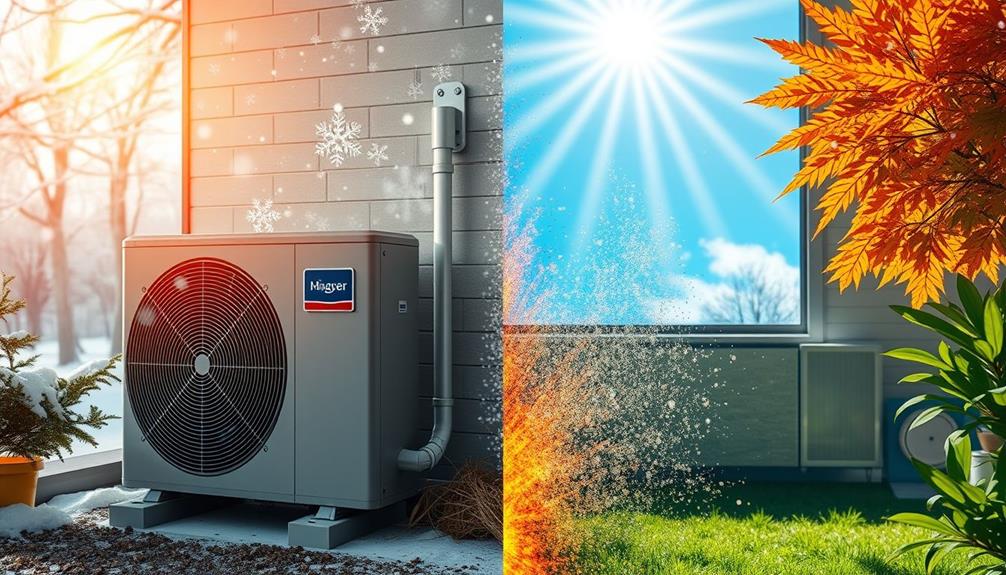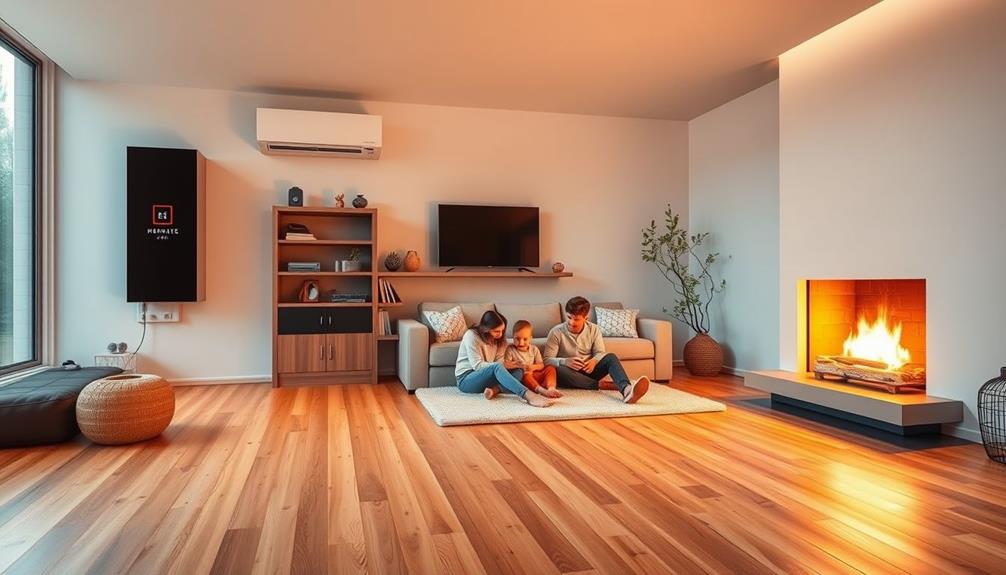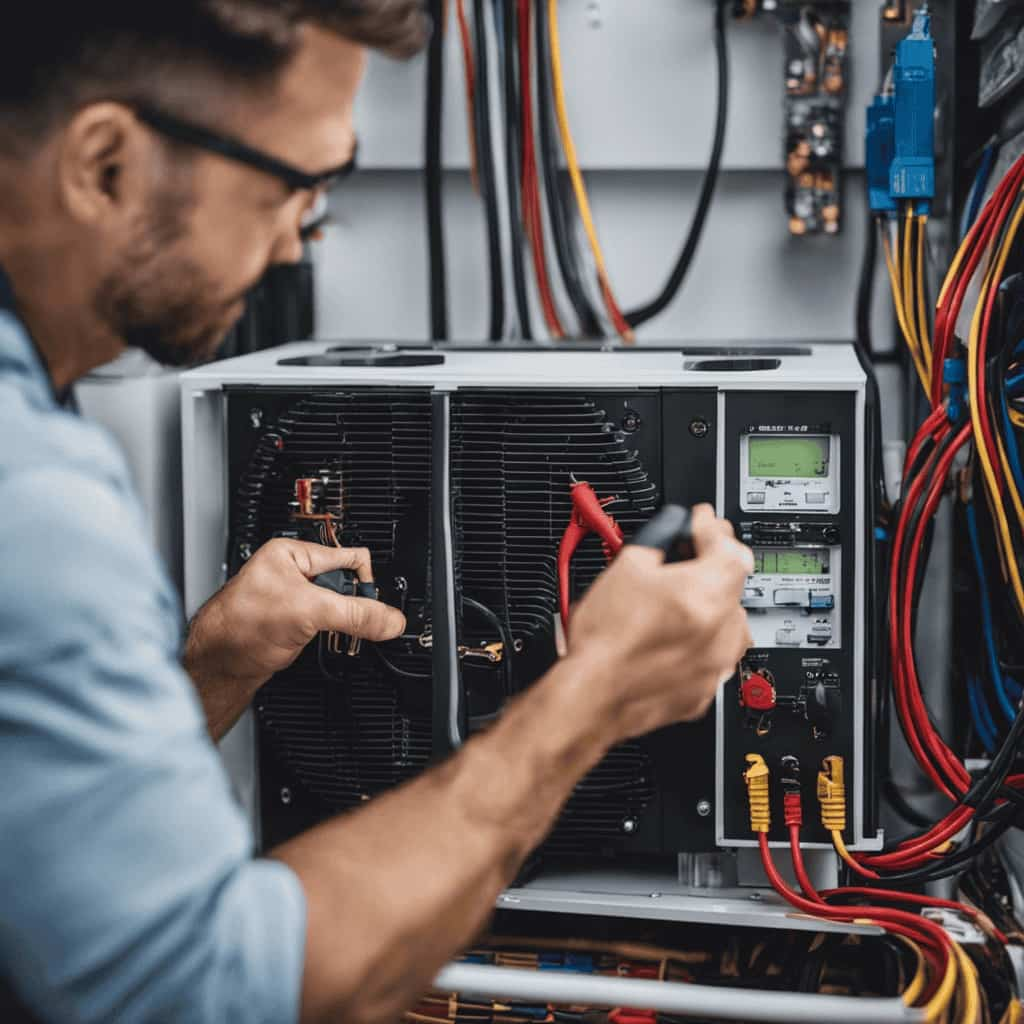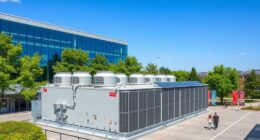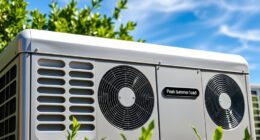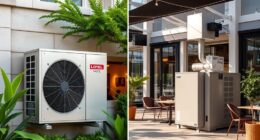Heat pumps are your go-to solution for temperature control, efficiently managing your home's heating and cooling. They work by transferring heat rather than generating it, using a refrigeration cycle with key components like the compressor, condenser, expansion valve, and evaporator. In heating mode, they extract warmth from the outdoor air and bring it indoors. When you need cooling, they absorb indoor heat and release it outside. With impressive energy efficiency metrics, heat pumps can considerably cut your energy bills. Discover how these systems operate and their benefits for your home comfort as you explore further.
Key Takeaways
- Heat pumps operate by transferring heat using a cycle involving a compressor, condenser, expansion valve, and evaporator for efficient heating and cooling.
- In heating mode, heat is extracted from outdoor air and transferred indoors, while in cooling mode, indoor heat is released outside.
- The Coefficient of Performance (COP) for heat pumps ranges from 2.0 to 5.4, indicating they produce significantly more heating energy than they consume.
- Regular maintenance, including cleaning filters and scheduling professional checks, is essential for optimal performance and energy efficiency.
- Different types of heat pumps exist, including air-source and ground-source systems, each suited for specific climates and efficiency needs.
Overview of Heat Pumps
Heat pumps are a smart choice for those looking to efficiently manage their building's climate. These versatile systems provide heating, cooling, and hot water by transferring heat rather than generating it, making them energy-efficient alternatives to traditional HVAC systems.
They operate using a refrigeration cycle, which involves a compressor, condenser, expansion valve, and evaporator that work together to absorb and release heat as needed. Regular maintenance is critical to guarantee ideal refrigerant levels and system performance, as neglecting it can lead to reduced efficiency and increased likelihood of heat pump failures.
One considerable advantage of heat pumps is their ability to extract heat from outdoor air, even in winter. With a Coefficient of Performance (COP) ranging from 2.0 to 5.4, they can produce 2.5 to 4.5 times more heating energy than the electrical energy they consume.
Common types include air-source systems, popular in residential applications, and ground-source (geothermal) systems, which offer high efficiency due to stable underground temperatures.
Integrating heat pumps into your building can lead to substantial long-term energy savings and impressive environmental benefits. By relying on renewable energy sources, they greatly reduce greenhouse gas emissions, making them an eco-friendly choice for those committed to sustainability.
How Heat Pumps Work
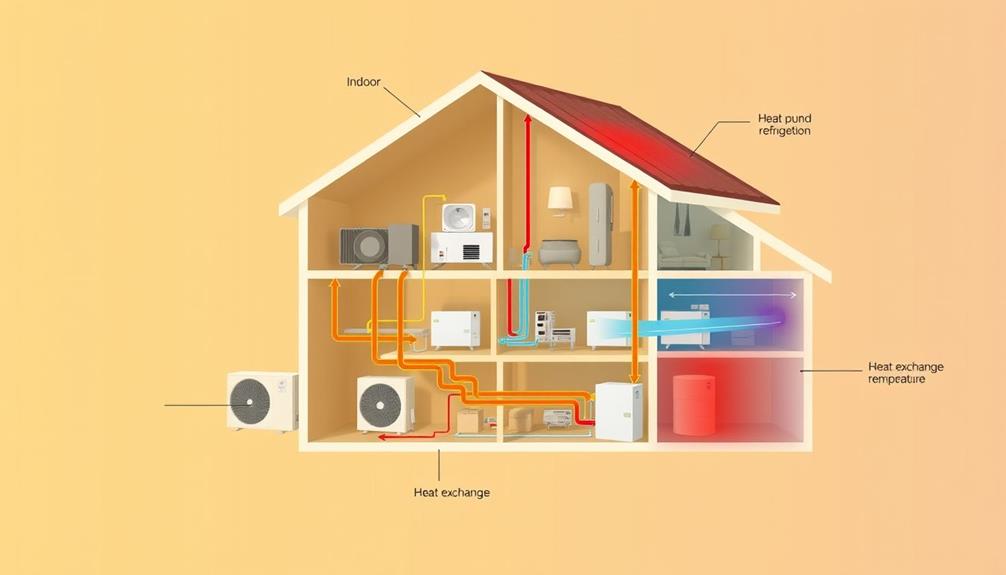
How do heat pumps manage to efficiently heat and cool your space? Heat pumps operate using a heat transfer process that moves heat rather than generating it. In heating mode, Air-Source Heat Pumps extract thermal energy from outdoor air, even in cold temperatures, and transfer it indoors. Conversely, during cooling, they absorb heat from indoor air and release it outside.
By maintaining good indoor air quality with devices like air purifiers, you can enhance the comfort of your living space while using heat pumps for climate control, as they can effectively work together to minimize allergens and pollutants in the air vital for individuals with allergies.
The system consists of four main components: the compressor, condenser, expansion valve, and evaporator, each important for absorbing and releasing heat. The refrigerant circulates through these components, allowing the heat pump to adapt to your heating or cooling needs.
The efficiency of heat pumps is often measured using the Energy Efficiency Ratio (EER) or Coefficient of Performance (COP). Air-source models typically achieve COPs ranging from 2.0 to 5.4 at 8°C, proving they're energy efficient compared to traditional heating systems.
Regular maintenance is necessary for ensuring your heat pump operates effectively, preventing issues like short cycling and enhancing overall performance.
Key Components of Heat Pumps
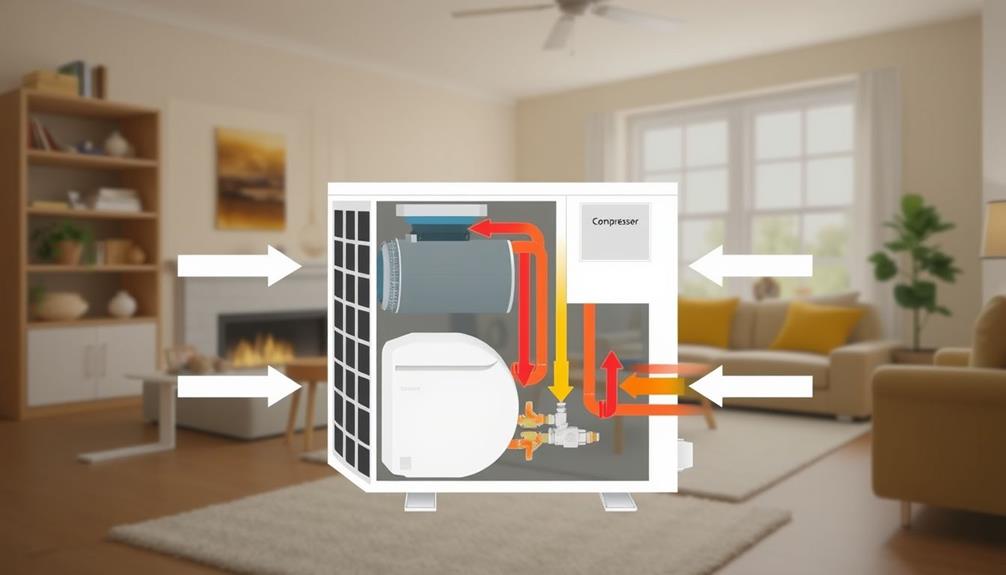
At the heart of every heat pump lies a set of key components that work in unison to provide efficient heating and cooling. The heat pump system primarily consists of four main parts: the compressor, condenser, expansion valve, and evaporator. Each plays a significant role in the refrigeration cycle.
Regular maintenance of these systems can enhance their efficiency and extend their lifespan, much like regular inspections can prevent leaks in toilets toilet maintenance tips.
The compressor circulates the refrigerant, raising its pressure and temperature to facilitate heat transfer. As the refrigerant flows into the condenser, it releases heat absorbed from your home's indoor coil into the environment, causing the refrigerant to change from gas to liquid. This process is fundamental for efficient heating.
Next, the expansion valve comes into play, lowering the pressure of the refrigerant before it enters the evaporator. This drop in pressure allows the refrigerant to absorb heat from the surrounding air or ground, transforming back into gas.
The evaporator is essential for both heating and cooling functions, making it a critical component of the heat pump system. Together, these components guarantee effective heat transfer, enabling your heat pump to maintain a comfortable indoor environment throughout different seasons.
Understanding these key components helps you appreciate how your home stays cozy year-round.
Heating and Cooling Cycles
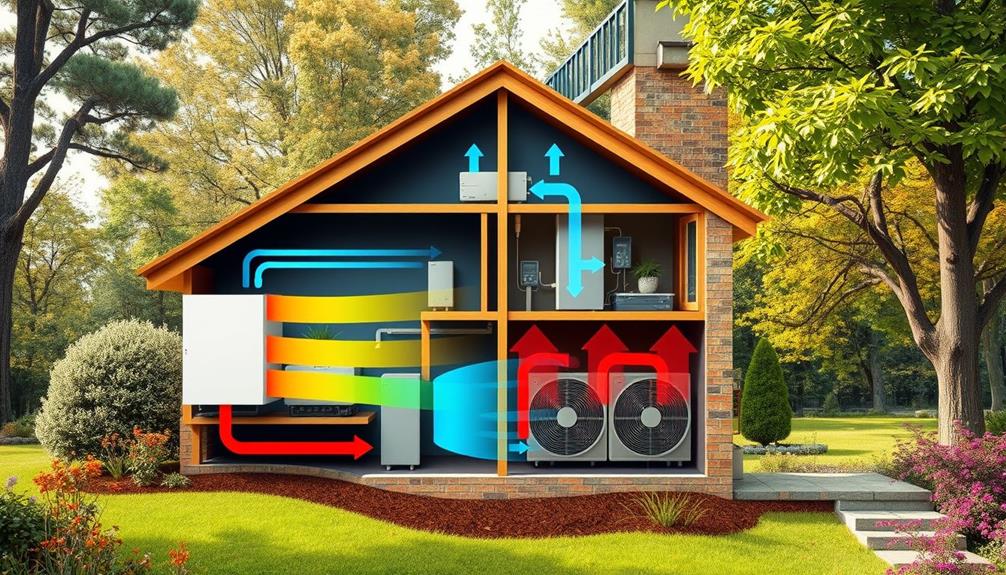
Understanding the heating and cooling cycles of your heat pump is vital for maximizing its efficiency. In the cooling cycle, the heat pump absorbs heat from the indoor air using refrigerant in the evaporator. This refrigerant then vaporizes, is compressed, and releases heat outside via the condenser, effectively cooling your home.
Conversely, during the heating cycle, the process reverses. The heat pump extracts thermal energy from outdoor air—yes, even when it's cold—and transfers it indoors, making use of the refrigerant's phase change from liquid to vapor.
Certain fields remain resilient against AI disruption, highlighting the importance of understanding complex systems like heat pumps.
In the colder months, the defrost cycle comes into play. This cycle temporarily switches your heat pump to cooling mode to melt any frost buildup on the outdoor coil, guaranteeing it continues to heat efficiently.
Regular maintenance is vital for both cycles, as it helps prevent issues like short cycling and guarantees peak performance throughout the year.
Efficiency and Performance Metrics
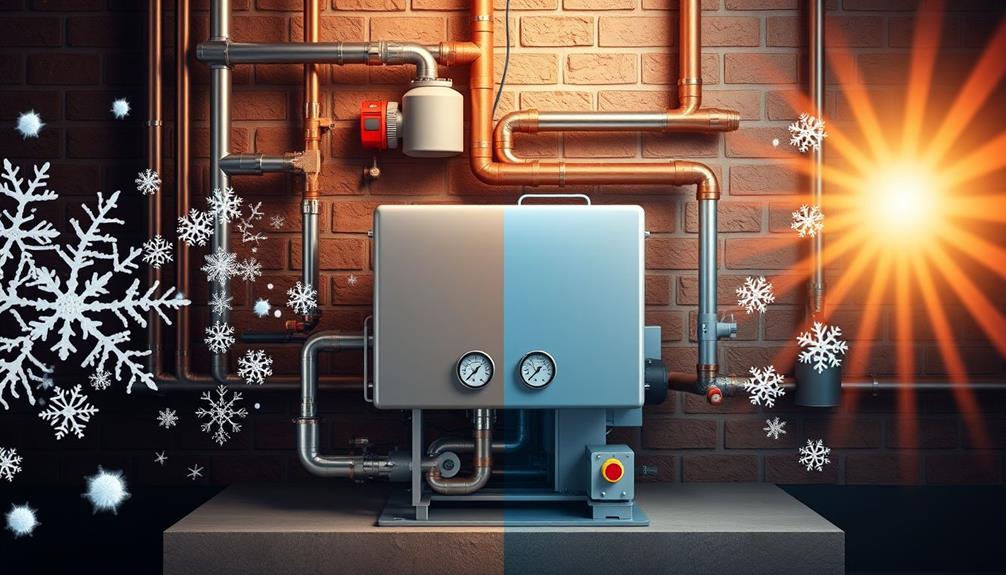
When you're considering heat pumps, understanding efficiency terminology is key to making informed choices. The energy efficiency of a heat pump can greatly affect your long-term costs, similar to how gout management insights can help alleviate discomfort and expenses related to health.
You'll want to compare performance metrics like COP, EER, HSPF, and SEER to gauge how well a system operates and how much you can save on energy costs.
Let's explore how these metrics not only reflect performance but also impact your wallet over time.
Efficiency Terminology Explained
Efficiency metrics play an essential role in evaluating heat pump performance, helping you determine the best system for your needs. The Coefficient of Performance (COP) indicates how effectively a heat pump converts electrical energy into thermal energy. A COP of 3 means that for every 1 kW of electricity you use, the system produces 3 kW of heat.
For cooling, the Energy Efficiency Ratio (EER) measures steady-state cooling efficiency, comparing cooling capacity in Btu/h to electrical input in watts. Investing in efficient systems can lead to financial benefits, much like diversifying your portfolio with options like a Gold IRA, which serves as a hedge against economic fluctuations.
When considering heating, the Heating Seasonal Performance Factor (HSPF) reflects the total heating output over an entire season relative to energy consumed, making it easier to compare different systems. Similarly, the Seasonal Energy Efficiency Ratio (SEER) assesses cooling efficiency over the cooling season, with higher SEER values indicating better performance.
Air-source heat pumps typically boast a COP range from 2.0 to 5.4 at 8°C, showcasing their superior efficiency compared to traditional heating systems like furnaces and boilers. This efficiency leads to lower energy consumption and reduced utility bills, providing significant long-term savings for homeowners.
Understanding these metrics is vital for making informed decisions.
Performance Metrics Comparison
Comparing performance metrics is essential for selecting the right heat pump for your home. You'll want to focus on key indicators like the Coefficient of Performance (COP), Energy Efficiency Ratio (EER), Heating Seasonal Performance Factor (HSPF), and Seasonal Energy Efficiency Ratio (SEER).
The COP shows how efficiently your heat pump can convert electrical energy into thermal energy, with a range of 2.0 to 5.4 at 8°C. This means it can produce up to five times more heating than the energy it consumes. For instance, understanding these metrics can help you recognize how heat pumps can contribute to energy efficiency, similar to geothermal energy generation, which utilizes Earth's heat for reliable power.
The EER measures cooling efficiency under steady-state conditions, helping you understand performance during peak cooling times. HSPF assesses the total heating output against energy consumed over a heating season, giving you insight into seasonal efficiency. Similarly, SEER evaluates cooling efficiency throughout the cooling season, allowing for direct comparisons between systems.
Air-source heat pumps often outperform traditional heating systems, providing significant energy savings and lower utility bills.
Energy Cost Reduction
Reducing energy costs is a primary benefit of using heat pumps, thanks to their impressive efficiency metrics. Heat pumps can achieve a Coefficient of Performance (COP) of 3 to 5.4, meaning they can deliver 2.5 to 4.5 times more energy in heating or cooling than the electrical energy consumed. This high energy efficiency translates to significant cost savings on your utility bills.
Incorporating a holistic lifestyle approach, similar to what's suggested for menopause management, can further enhance your overall well-being while you enjoy the benefits of a heat pump.
The Heating Seasonal Performance Factor (HSPF) and Seasonal Energy Efficiency Ratio (SEER) are essential for evaluating heat pump performance. A higher HSPF rating indicates better heating efficiency, while a higher SEER rating reflects improved cooling efficiency. By utilizing air-source heat pumps, you can reduce your energy consumption by 30-60% compared to traditional systems like furnaces or boilers.
Moreover, the Energy Efficiency Ratio (EER) plays an important role in determining cooling efficiency, helping you gauge how much you'll save over time. When you select a heat pump with excellent efficiency metrics, you're not just investing in comfort; you're also ensuring long-term energy cost reduction, making your home more sustainable and your wallet happier.
Types of Heat Pumps
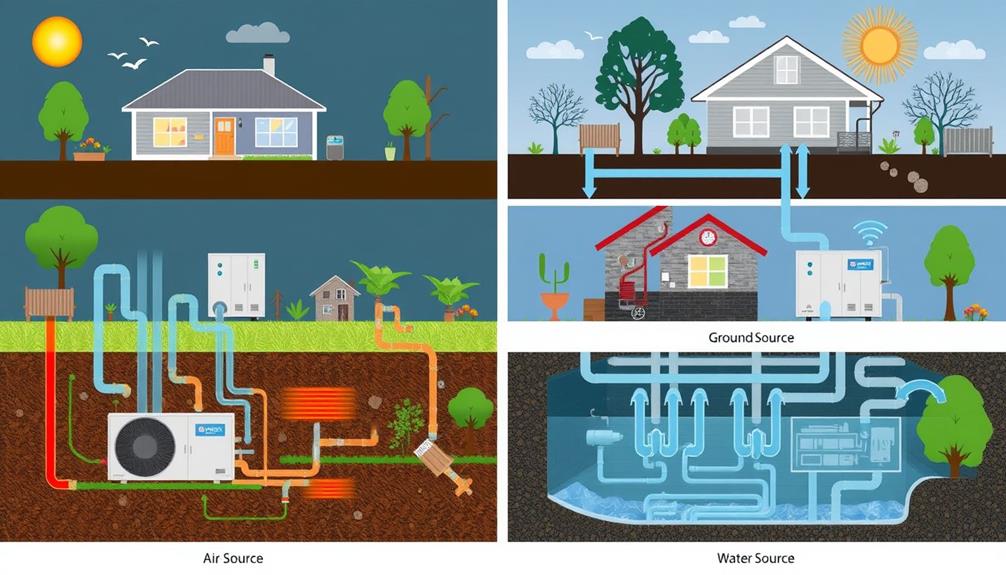
When it comes to heating and cooling your home, understanding the different types of heat pumps can make a significant difference in your comfort and energy costs.
Air-source heat pumps are the most common, effectively transferring heat between indoor and outdoor air, especially in moderate climates. If you're looking for higher efficiency, consider ground-source heat pumps; they utilize stable underground temperatures, although they require a higher initial investment.
Additionally, using high-quality equipment can enhance the efficiency of your heating system, similar to pool maintenance equipment that guarantees cleanliness and peak performance.
You'll also encounter ducted systems, which distribute heated or cooled air through existing ductwork, and ductless systems, providing direct heating or cooling to specific rooms. This flexibility can suit various home layouts.
If you live near a water body, water-source heat pumps can be an option, using water temperature for efficient heating and cooling, often in commercial settings.
Lastly, absorption heat pumps stand out as they can operate using various thermal energy sources, like natural gas or solar energy.
All these options leverage advanced heat pump technology to enhance your heating and cooling efficiency, whether in heating mode or cooling mode. Choose wisely to maximize your comfort and minimize energy costs!
Maintenance and Troubleshooting Tips
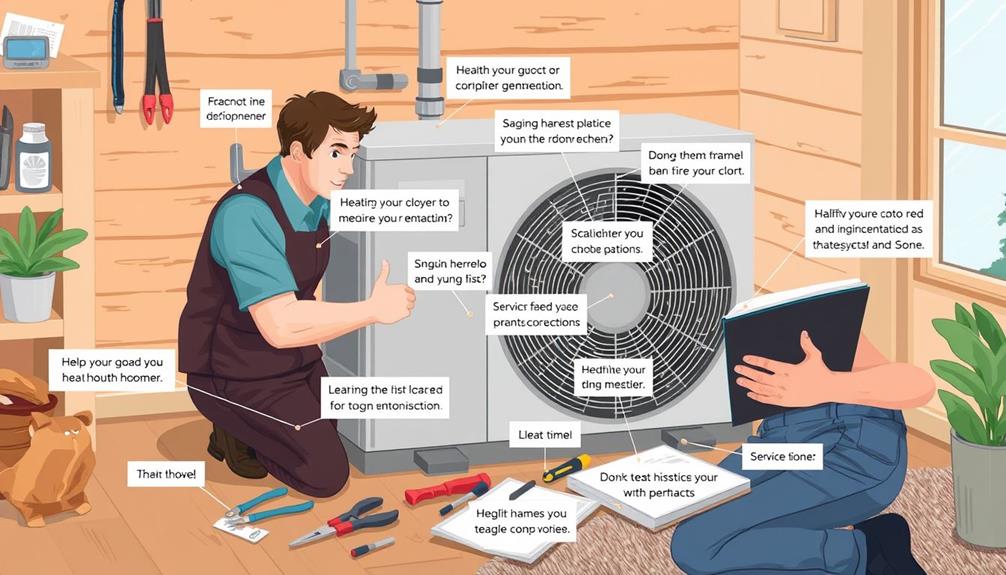
When it comes to keeping your heat pump running smoothly, regular maintenance is key. You should check and replace air filters every 1-3 months, and don't ignore any unusual noises or performance changes.
Additionally, understanding dog health and care can help you recognize signs of discomfort in pets during temperature changes in your home.
Let's explore some common issues and troubleshooting tips that can help you address problems before they turn into costly repairs.
Regular Maintenance Tasks
Regular maintenance tasks for your heat pump are vital for ensuring its best performance and longevity.
Start by cleaning or replacing air filters every 1-3 months to maintain ideal airflow. This simple action can reduce energy consumption by up to 15%.
Be sure to inspect and clear debris from the outdoor unit, like leaves or snow, to promote proper heat exchange and prevent performance issues.
Scheduling annual professional maintenance checks is important. Technicians can identify and resolve potential issues early, enhancing system longevity and efficiency, potentially saving you up to 30% on energy bills.
Keeping your thermostat calibrated helps avoid short cycling, reducing wear on the system and preventing a 10-20% increase in utility costs.
Common Issues Identified
Even with regular maintenance, heat pumps can still experience issues that affect their performance. One common problem is short cycling, which can signal inefficiency. This often stems from incorrect sizing, refrigerant leaks, or clogged air filters.
If you notice strange noises, uneven temperature distribution, or unexpected spikes in energy bills, it's time for an inspection.
When troubleshooting short cycling, start by checking for refrigerant leaks and replacing dirty air filters. A clogged air filter can drastically reduce heat pump efficiency, making it work harder and increasing your energy bills.
Also, assess the thermostat functionality to verify it's properly communicating with your unit.
Ignoring these signs can lead to more significant issues down the line, so timely intervention is essential. While you can handle some basic maintenance, don't hesitate to seek professional HVAC services for accurate diagnosis and repairs.
Technicians have the specialized knowledge needed to address heat pump issues effectively and can help guarantee your system runs smoothly. Regular maintenance not only enhances performance but also extends the life of your heat pump, saving you money in the long run.
Troubleshooting Tips Provided
To keep your heat pump running efficiently, you should adopt a proactive approach to maintenance and troubleshooting. Regular maintenance is essential to prevent issues like short cycling, which often signals inefficiency.
Start by inspecting the thermostat for calibration problems. If you notice unusual noises, uneven temperatures, or spikes in your energy bills, these could be warning signs of short cycling.
Check for refrigerant leaks, as these can greatly impact your system's performance. Additionally, make sure there's no obstruction limiting airflow to your heat pump. Clogged air filters can also cause short cycling, so it's important to replace them regularly. This simple task can greatly enhance your heat pump's efficiency.
Don't forget about airflow around the outdoor unit; keeping this area clear is essential for ideal operation.
To catch potential problems early, schedule annual maintenance checks with a professional. These checks not only help maintain system performance but also extend the life of your heat pump.
Frequently Asked Questions
How Long Should a Heat Pump Stay off Between Cycles?
Your heat pump should stay off between cycles for about 10 to 15 minutes. This helps stabilize the system, prevents short cycling, and guarantees efficiency, ultimately saving you on energy bills and prolonging component life.
How Does a Heat Pump Cycle Work?
A heat pump cycle works by transferring heat from one area to another. It absorbs heat indoors, compresses it, and releases it outside for cooling, or reverses the process for heating, efficiently maintaining comfort.
How Does a Heat Pump Heat and Cool a House?
A heat pump heats your house by extracting outdoor heat and transferring it indoors. When cooling, it reverses this process, pulling indoor heat outside. This efficient method keeps your home comfortable year-round without excessive energy use.
At What Temperature Is a Heat Pump Most Efficient?
When it comes to efficiency, you'll find a heat pump shines best between 10°C to 15°C. In that sweet spot, it extracts heat effectively, giving you maximum comfort without breaking the bank on energy costs.
Conclusion
In the world of home comfort, heat pumps are like the skilled circus performers, effortlessly juggling warmth and coolness to keep your space just right. They dance through cycles, adapting to the seasons while maintaining efficiency like a well-rehearsed act. By understanding their rhythm and caring for their needs, you can guarantee your home remains a cozy haven year-round. So, embrace the magic of heat pumps, and let them turn your living space into a comfortable masterpiece.
